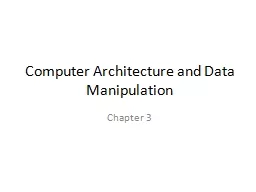

Chapter 3 Von Neumann Architecture Todays storedprogram computers have the following characteristics Three hardware systems A central processing unit CPU Arithmetic and Logic Unit ALU ID: 151406
Download Presentation The PPT/PDF document "Computer Architecture and Data Manipulat..." is the property of its rightful owner. Permission is granted to download and print the materials on this web site for personal, non-commercial use only, and to display it on your personal computer provided you do not modify the materials and that you retain all copyright notices contained in the materials. By downloading content from our website, you accept the terms of this agreement.
Slide1
Computer Architecture and Data Manipulation
Chapter 3Slide2
Von Neumann Architecture
Today’s stored-program computers have the following characteristics:
Three hardware systems:
A central processing unit (CPU
)
Arithmetic and Logic Unit (ALU)
Control Unit
Registers
A main memory system
An I/O system
The capacity to carry out sequential instruction processing.
A single data path between the CPU and main memory
.Slide3
CPU
and main memory connected via a busSlide4
Stored Program Concept
A program can be encoded as bit patterns and stored in main memory. From there, the CPU can then extract the instructions and execute them. In turn, the program to be executed can be altered easily.
Slide5
Terminology
Machine instruction:
An instruction (or command) encoded as a bit pattern recognizable by the CPU
Machine language:
The set of all instructions recognized by a machineSlide6
Machine Language Philosophies
Reduced Instruction Set Computing (RISC)
Few, simple, efficient, and fast instructions
Examples: PowerPC from Apple/IBM/Motorola
and
SPARC
from Sun Microsystems
Complex Instruction Set Computing (CISC)
Many, convenient, and powerful instructions
Example: Pentium from IntelSlide7
Machine Instruction Types
Data Transfer: copy data from one location to another
Arithmetic/Logic: use existing bit patterns to compute a new bit patterns
Control: direct the execution of the programSlide8
Example -
Adding
values stored in memorySlide9
Example -
Dividing
values stored in memorySlide10
Program Execution
Controlled by two special-purpose registers
Program
Counter
: address of next instruction
Instruction
Register
: current instruction
Machine Cycle
Fetch
Decode
ExecuteSlide11
The machine cycleSlide12
Program Execution
Controlled by two special-purpose registers
Program counter: address of next instruction
Instruction register: current instruction
Machine Cycle
Fetch
Decode
ExecuteSlide13
The architecture of the machine described in Appendix CSlide14
Start of the Fetch Execute cycle
All of the instructions were fetched and executed as part of the machine cycleSlide15
Performing
the fetch step of the machine cycleSlide16
Performing
the fetch step of the machine cycle (cont’d)Slide17
Parts of a Machine Instruction
Op-code:
Specifies which operation to execute
Operand:
Gives more detailed information about the operation
Interpretation of operand varies depending on op-codeSlide18
The
composition of an instruction for the machine in Appendix C
3 means to
store the contents
of a register to memory
From register
5
To memory address A7Slide19
Appendix C:
A Simple Machine Language
Op-code
Operand
Description
1 RXY
LOAD
reg. R from cell XY.
2 RXY
LOAD
reg. R with XY.
3 RXY
STORE
reg. R at XY.
4 0RS
MOVE
R to S.
5 RST
ADD
S and T into R. (2’s comp.)
6 RST
ADD
S and T into R. (floating pt
.)
7
RST
OR
S and T into R.
8 RST
AND
S and T into R.
9 RST
XOR
S and T into R.
A R0X
ROTATE
reg. R X times.
B RXY
JUMP
to XY if R = reg. 0.
C 000
HALT.
D 0XY JUMP to XY alwaysSlide20
Sample Machine Program
PC = 0
Mem
Address Contents
0 1506
1 1607
2 5056
3 3008
4 C000
5 0001
6 0002
7 0003
8 0000Slide21
Exercise
PC = 0
Write a program that subtracts 1 from the value in memory address FFSlide22
Another Program – What’s it do?
PC = 0
Address
Contents
0
20FF
1
2102
2
2200
3
130A
4
5223
5
5110
6
B108
7
D004
8
320A
9
C000
A
0003Slide23
Exercise
Write a program that computes the opposite of the value in memory address FF
E.g. if the value is +5 then it becomes -5Slide24
Communicating with Other Devices
Controller:
An intermediary apparatus that handles communication between the computer and a device
Specialized controllers for each type of device
General purpose controllers (USB and FireWire)
Port:
The point at which a device connects to a computer
Memory-mapped I/O:
CPU communicates with peripheral devices as though they were memory cellsSlide25
Controllers
attached to a machine’s busSlide26
A
conceptual representation of memory-mapped I/OSlide27
Communicating with Other Devices
(continued)
Direct memory access (DMA):
Main memory access by a controller over the bus
Von Neumann Bottleneck:
Insufficient bus speed impedes performance
Handshaking:
The process of coordinating the transfer of data between components Slide28
Communicating with Other Devices
(continued)
Parallel Communication:
Several communication paths transfer bits simultaneously.
Serial Communication:
Bits are transferred one after the other over a single communication path.Slide29
Data Communication Rates
Measurement units
Bps: Bits per second
Kbps: Kilo-bps (1,000 bps)
Mbps: Mega-bps (1,000,000 bps)
Gbps: Giga-bps (1,000,000,000 bps)
Bandwidth: Maximum available rateSlide30
Increasing Performance
Technologies to increase throughput
:
Faster clock speed
Bigger word size
Larger cache memory
Pipelining: Overlap steps of the machine
cycleSlide31
Pipelining
Why
not start fetching the next instruction while we’re decoding the current instruction?
Why
not decode the next instruction while we’re executing the current instruction?
What if Instruction 1 is the
JUMP to XY if R = reg.
0 instruction and we JUMP? Slide32
Increasing Performance
Parallel Processing: Use multiple processors simultaneously
SISD: No parallel processing
MIMD: Different programs, different
data
Dual core, quad core
SIMD: Same program, different
data
SSE, MMX